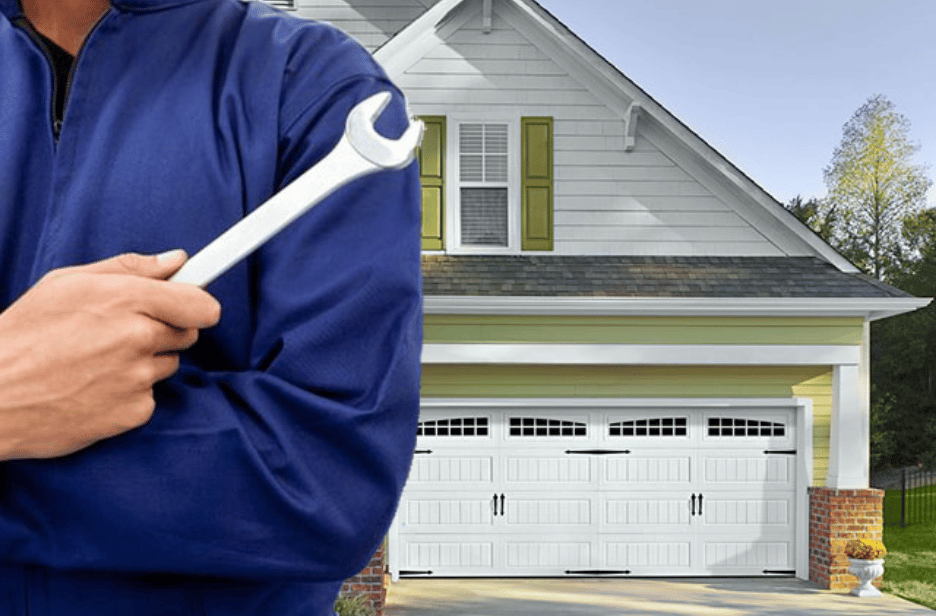An estimated 76 percent of Americans drive to work every day, according to a survey from Brookings. We depend on our cars, which is why when the garage door gets stuck in the closed position with your car inside, it can cause a huge flood of emotions. How will you open the door to drive to work? Don’t panic. If your garage door is stuck, you can fix it.
What to Do
To start, shut off the car. You don’t want to run your car in a closed garage because the carbon monoxide fumes from the car can kill you in under five minutes. Worse, you wouldn’t know it because of its odorless and colorless appearance. Maybe the garage door is stuck because of garage door broken springs. For cases like that, you need to call a technician. Don’t work with the springs yourself because you could suffer an injury or death if the springs break.
Dead Battery?
Sometimes, you can resolve the problem through something as simple as changing out a dead battery. We would advise that you check this first because you can resolve this the easiest. First, check that the batteries in the remote still function. You can tell that the batteries don’t work in the remote because of how the other opening mechanisms of the garage door will work correctly.
You may want to check the connectors of the garage door remote. The central center for operation uses electricity to work, and if the unit is unplugged for some reason, it could cause a garage door that won’t open.
Garage Door Is Stuck Closed With Your Car Inside
Luckily, the designers planned for when garage doors stick. They created a way to open the door manually. Simply look for the emergency release cord and pull it. Usually, they made it a bright color like red. This releases an automatic lift system that will open the garage door so that you can drive to work.
In most cases, opening the door manually will fix the problem. However, you do have cases where the garage door falls off the track. Run inside and call a technician. Don’t try to fix this yourself. Trying to fix a garage door that ran off the track can be dangerous. In many cases, garage doors require the expertise of a professional.
Sensors Of The Garage Door
In some cases, the sensors on the garage door may be bent, which causes them to be off toward each other. Usually, the garage door stays open when the sensors don’t work, but it depends on the circumstances. You can tell that the sensors are out of alignment because the LED lights will blink when you attempt to open them. Red lights indicate an issue with the sensors. Green lights mean that everything works properly.
You may attempt to clean the sensor as a way to open your garage door.
How It Affects Your Garage Door
Excessive humidity can interfere with the garage door. Wooden garage doors in particular struggle with humidity. As the air gets more humidity, it can cause the wood of the garage to swell, which causes problems.
Why Do Garage Door Springs Break?
Garage door springs break because of wear and tear. Over time, rust may start to form as humidity exposes the metal springs to moisture. Galvanized springs don’t experience the same danger of rusting as other springs because of a protective layer. The risk of a deadly failure increases as the extension springs wear out with time.
How Long Does a Garage Door Last?
Most garage door experts like the ones at Evergreen garage door agree that the springs will last roughly 10,000 cycles or seven years. That looks at average use, which means you open and close your garage door four times per day. This daily winding up and unwinding can eventually lead to the spring breaking if you don’t have a technician to replace it beforehand.
Signs of a Broken Garage Door Spring
You have a few signs that the garage door spring has broken. Look for a 2-inch gap on the spring, which indicates that a break occurred. Other signs can point to a broken garage door as well, such as the door closing with greater force, the door not opening or closing, the door appearing crooked as it closes or the door opening only a couple of inches before it closes.
What Happen If A Spring Broke?
Garage door broken spring should have the door left closed. If the door remains in the open position, only close it if you can safely do so. Use the click from afar to close the door. Unplug the garage door opener from the wall to ensure that no one accidentally opens it. Otherwise, call in a technician to do it. Don’t risk injury.
You may think of breaking a finger as minor, but don’t underestimate the damage. We know of someone who worked on a garage door spring. It snapped and broke his thumb. The thing is, it did more than break his thumb. The spring caused permanent nerve damage so that he could never use that hand again. On top of that, when the spring broke, it ricocheted and smashed him in the face. The power behind the spring caused a massive laceration. Don’t underestimate broken garage door springs. Even torsion springs pose a danger.
Many Stories Of Injury
Unfortunately, you have many stories of broken garage door springs that injured someone. Only after they suffered an injury did they call us. We hope that it doesn’t require broken garage door springs before you call. Our experts have the tools and understanding to work on extension springs safely. Luckily, you don’t have to replace garage door springs often. Having a technician replace a garage door spring costs anywhere from $100 to $300, but you will feel grateful that you didn’t risk an injury.
Garage doors are essential for the safety and security of your home. They can protect from hazards such as direct, overhead lighting or falling objects. A garage door is also a place where you can hide valuables such as your bike and pet. However, if you don’t take proper care of it and it’s not repaired correctly, it will break down over time and become a safety hazard. A garage door is a large and heavy object, so you want to ensure that it is correctly maintained by an expert if something goes wrong.
Where To Find the Springs On Your Garage Door
The location of the garage door springs vary. Torsion springs, usually much larger, will sit above the garage door. Extension springs are usually between 2 to 4 feet in length. You can see them above the tracks, but most of the newer models use a torsion spring because broken garage door springs from a torsion spring don’t pose the same danger. Not only does it improve safety, but they last longer and are sturdier. Still, call the experts even with a torsion spring.
The new garage door includes safety cables on the springs to hold it in place. In the past, garage door springs could break with such momentum that they would smash through a wall and injure the person in the next room. If a spring on the garage door has broken, do not open the door. You increase the pressure on the working springs and have a high risk of it breaking. Call Evergreen garage door for broken garage door springs. Garage door springs deal with the most pressure as the door closes. Because of this, they often break with the door closed.
Your garage door is a crucial residential component that ensures the security of your vehicle and personal property. Since garage doors suffer frequent damage, garage door maintenance is inevitable.
You may think that garage door issues are easy to fix, but it is sometimes untrue. You can do straightforward issues for yourself, such as lubricating door tracks. However, hire a professional garage door repair provider to avoid harming yourself and inflicting further damage on the door. We have you covered if you search for garage door repair near me. We can help fix broken garage door springs, door openers, and a door that has slipped off its track. Continue reading to learn about garage door repair services.

